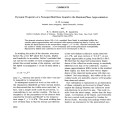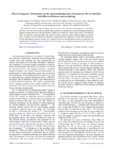|
|
Creator | Title | Description | Subject | Date |
| 151 |
 |
Vardeny, Zeev Valentine | Directional emission from asymmetric microlaser resonators of ∏-conjugated polymers | A ∏-conjugated polymer film was fabricated into an asymmetric microlaser resonator having a quadrapole deformation with irregular boundaries and a Q factor of 600. At high excitation intensities above the threshold for lasing, we observed multimode laser emission spectra and directional emission a... | Directional emission; Asymmetric microlaser resonators; pi-conjugated polymers; DOO-PPV; poly(dioctyloxy) phenylene vinylene | 2004 |
| 152 |
 |
Gondolo, Paolo | Directional recoil rates for WIMP direct detection | New techniques for the laboratory direct detection of dark matter weakly interacting massive particles (WIMPs) are sensitive to the recoil direction of the struck nuclei.We compute and compare the directional recoil rates dR/d cosθ, (where θ is the angle measured from a reference direction in th... | WIMP; Weakly interacting massive particles; WMAP 3; Directional recoil; Halo models | 2008-02 |
| 153 |
 |
Symko, Orest George | Discrete spatial filtering with SQUID gradiometers in biomagnetism | First-, second-, and third-order gradiometers used in detecting biomagnetic signals are analyzed as spatial niters. Their transfer functions independent of the source to be measured are presented and both the magnitude and phase characteristics of the transfer functions are analyzed. The distortion ... | Spatial filtering; SQUID gradiometers; Fourier transform | 1986 |
| 154 |
 |
Vardeny, Zeev Valentine | Disorder-induced TA Raman lines in mixed Cu-halide crystals | The Raman spectra of CuClxBr1=x and CuBrxI1=x solid solutions are shown to contain extremely intense disorder-induced first-order TA phonons. The intensity of these lines is a function of the concentration x, and is highest in CuCl0.6oBr0.40. The TA spectrum, well resolved at low temperature, fits... | Cuprous halides; CuBr; CuCl; CuI; mixed Cu-halide crystals | 1979-03 |
| 155 |
 |
Vardeny, Zeev Valentine; Ehrenfreund, Eitan A. | Dispersion of resonant Raman scattering in ∏-conjugated polymers: role of the even parity excitons | Resonant Raman scattering dispersion of the most strongly coupled phonon frequencies with the excitation laser photon energy is measured in terms of a dispersion rate parameter D and quantified in a variety of p conjugated polymer films. D was found to be large in nonluminescent polymers and small i... | Resonant raman scattering; Even parity excitons | 1997-09 |
| 156 |
 |
Symko, Orest George | Does the quasicrystal AlCuFe follow Ohm's law? | We present the first measurements of the electrical I-V characteristics of AlCuFe quasicrystalline thin films processed by solid state interdiffusion of magnetron sputtered Al, Cu, and Fe layers. Despite the peculiar electronic properties of quasicrystals, our results show that those samples follow ... | AlCuFe; Quasicrystal | 1994-10 |
| 157 |
 |
Vardeny, Zeev Valentine | Double-modulation electro-optic sampling for pump-and-probe ultrafast correlation measurements | We describe a novel electro-optic double-modulation (DM) sampling technique for ultrafast transient spectroscopy, which is characterized by a superior signal-to-noise ratio compared to that of a regular single-modulation technique. DM is achieved by a combined effect of a radio-frequency modulation,... | Double-modulation; Electro-optic sampling; Ultrafast transient spectroscopy; Pump; Probe | 1998 |
| 158 |
 |
Gondolo, Paolo | DUSEL theory white paper | The scientific case for a Deep Underground Science and Engineering Laboratory [DUSEL] located at the Homestake mine in Lead, South Dakota is exceptional. The site of this future laboratory already claims a discovery for the detection of solar neutrinos, leading to a Nobel Prize for Ray Davis. Moreov... | DUSEL; Deep Underground Science and Engineering Laboratory; Proton decay | 2008 |
| 159 |
 |
Mattis, Daniel C. | Dynamic properties of a nonsuperfluid Bose liquid in the random-phase approximation | The dynamic structure factor S(k,w) of a nonideal Bose liquid is calculated within the random-phase approximation and compared with neutron scattering data by Cowley and Woods for liquid helium in the temperature range Tλ<T≤4.2°K, with the conclusion that the model is wholly inadequate. A low-f... | Bose liquid; Random-phase approximation; Overdamping | 1974-11 |
| 160 |
 |
Wu, Yong-Shi | Dynamics of giant-gravitons in the LLM geometry and the fractional quantum Hall effect | The LLM's 1/2 BPS solutions of IIB supergravity are known to be closely related to the integer quantum Hall droplets with filling factor v = 1, and the giant gravitons in the LLM geometry behave like the quasi-holes in those droplets. In this paper we consider how the fractional quantum Hall effect ... | | 2006 |
| 161 |
 |
Mattis, Daniel C. | Dynamics of quasiparticles in the two-dimensional Hubbard model | The Hubbard model at half-filling is a collective, antiferromagnetic insulator. We study added electrons or holes. The insulating energy gap and the dispersion of the added carriers are calculated variationally in two dimensions with use of a Monte Carlo evaluation of the electronic correlation f... | Dispersion; Electrons; Carriers | 1990 |
| 162 |
 |
Ailion, David Charles | Dynamics of the pinned modulation wave in incommensurate bis (4-chlorophenyl) sulfone (BCPS) | We show that both the anomalously huge resonance-frequency dependence of the 3 5Cl nuclear quadrupole resonance (NQR) spin-lattice relaxation time in BCPS, reported here for the first time, and its anomalous temperature dependence can be explained by large-scale fluctuations of the pinned modulation... | NQR; Spin-lattice; Relaxation-time; Pinned modulation wave | 2002 |
| 163 |
 |
Gondolo, Paolo | Effect of a late decaying scalar on the neutralino relic density | If the energy density of the Universe before nucleosynthesis is dominated by a scalar field Ø that decays and reheats the plasma to a temperature TRH smaller than the standard neutralino freeze-out temperature, the neutralino relic density differs from its standard value. In this case, the relic de... | Neutralinos; Relic density; Reheating temperature | 2006-10 |
| 164 |
 |
Mattis, Daniel C. | Effect of band structure on ferromagnetism* | We extend Nagaoka's study of the ferromagnetism of nearly half-filled bands in the infinite-repulsion limit of the Hubbard model by including next-nearest-neighbor tight-binding overlap matrix elements K2. Particles can now get past one another, even in one dimension. We find corroboration of Nagaok... | Eigenstates; Spin waves | 1974-08 |
| 165 |
 |
Vardeny, Zeev Valentine | Effect of bias illumination on photoinduced absorption decay in ?-Si:H | Zeldov and Weiser1 proposed a model to explain the influence of optical biasing on the decay of photoinduced absorption (PA) in ?-Si:H at high temperatures observed by Pfost, Vardeny, and Tauc.2 This model differs from the model originally used2 for interpreting the experimental data at temperatures... | Optical biasing; Bias illumination; Photoinduced absorption decay; a-Si:H; Amorphous silicon | 1985 |
| 166 |
 |
Sokolsky, Pierre | Effect of clouds on apertures of space-based air fluorescence detectors | Space-based ultra-high-energy cosmic ray detectors observe fluorescence light from extensive air showers produced by these particles in the troposphere. Clouds can scatter and absorb this light and produce systematic errors in energy determination and spectrum normalization. We study the possibilit... | Fluorescence; Cloud detection; Extensive air showers | 2004-01 |
| 167 |
 |
Symko, Orest George | Effect of crystal field on the magnetization of dilute hcp alloys | Magnetization measurements on very dilute single-crystal alloys of Mg-Mn, Zn-Mn, and Zn-Cr in the temperature range of 2-0.008 K show that the ground state of these systems is determined by fine-structure splitting. For Mg-Mn the fine-structure constant D is +0.006 K with an effective spin of f whil... | HCP alloys; Crystal field; Magnetization; Mg-Mn; Zn-Mn; Zn-Cr | 1982-04 |
| 168 |
 |
Gondolo, Paolo | Effect of dark matter on the first stars: a new phase of stellar evolution | Dark matter (DM) in protostellar halos can dramatically alter the current theoretical framework for the formation of the first stars. Heat from supersymmetric DM annihilation can overwhelm any cooling mechanism, consequently impeding the star formation process and possibly leading to a new stellar ... | Dark stars | 2008 |
| 169 |
 |
Mishchenko, Eugene | Effect of electron-electron interactions on the conductivity of clean graphene | Minimal conductivity of a single undoped graphene layer is known to be of the order of the conductance quantum, independent of the electron velocity. We show that this universality does not survive electron-electron interaction, which results in nontrivial frequency dependence. We begin with analyzi... | Optical conductivity; Perturbation theory | 2007-05 |
| 170 |
 |
Boehme, Christoph | Effect of exchange coupling on coherently controlled spin-dependent transition rates | The effect of exchange interactions within spin pairs on spin-dependent transport and recombination rates through localized states in semiconductors during coherent electron-spin resonant excitation is studied theoretically. It is shown that for identical spin systems, significant quantitative diff... | Spin coherence; Electron spin nutations | 2008-06 |
| 171 |
 |
Mattis, Daniel C. | Effect of exciton hopping upon the mass of an exciton | A plausible formula derived in a previous paper for the mass Mn* of an exciton in an nth bound state of the electron-hole binding potential is extended so as to include the effect of an exciton-hopping (or Heller-Marcus) mechanism upon Mn*. | Frenkel excitons; Exciton-hopping; Heller-Marcus energy; Binding potential | 1985-10 |
| 172 |
 |
Gerton, Jordan | Effect of magnetic Gd impurities on the superconducting state of amorphous Mo-Ge thin films with different thickness and morphology | We studied the effect of magnetic doping with Gd atoms on the superconducting properties of amorphous Mo70Ge30 films. We observed that in uniform films deposited on amorphous Ge, the pair-breaking strength per impurity strongly decreases with film thickness initially and saturates at a finite value ... | | 2012-01-01 |
| 173 |
 |
Rogachev, Andrey | Effect of morphology on the superconductor-insulator transition in one-dimensional nanowires | We study the effect of morphology on the low-temperature behavior of superconducting nanowires which vary in length from 86 nm to 188 nm. A well-defined superconductor-insulator transition is observed only in the family of homogeneous wires, in which case the transition occurs when the normal resist... | One-dimensional wires; Superconductor-insulator transition; Homogeneous wires; Inhomogeneous wires; Morphology; Low-temperature behavior | 2004-05 |
| 174 |
 |
Gondolo, Paolo | The effect of quark interactions on dark matter kinetic decoupling and the mass of the smallest dark halos | The kinetic decoupling of dark matter (DM) from the primordial plasma sets the size of the first and smallest DM halos. Studies of the DM kinetic decoupling have hitherto mostly neglected interactions between the DM and the quarks in the plasma. Here we illustrate their importance using two framewor... | | 2012-01-01 |
| 175 |
 |
Symko, Orest George | Effect of RKKY interactions on the magnetization of dilute magnetic alloys with hcp hosts | The magnetization due to the presence of magnetic impurities dissolved dilutely in nonmagnetic H.C.P. host metals has been calculated assuming a fine structure splitting by an axially symmetric crystal field and an RKKY interaction between the impurities. To compute the RKKY contribution, the inte... | RKKY interactions; Dilute magnetic alloys; HCP hosts; MgMn; ZnMn | 1981 |

























